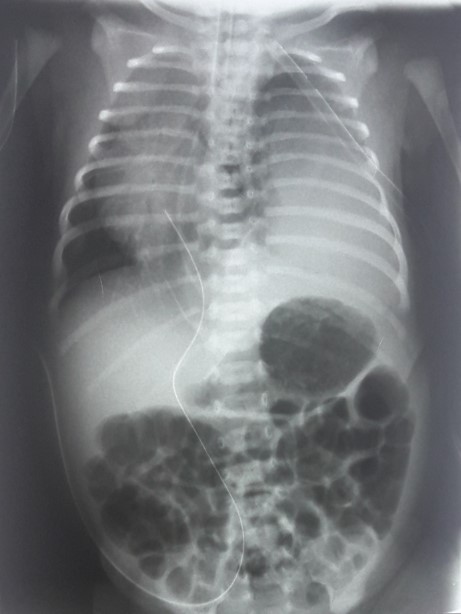Pulmonary sequestration in a newborn presenting acute respiratory insufficiency -case report
Main Article Content
Abstract
Background: Pulmonary sequestration is a congenital malformation of the airway. Although it is usually diagnosed during childhood, some cases go entirely unnoticed, and others, like the one in this report, have an acute and infrequent presentation. Case report: the case of a newborn with acute respiratory failure due to a large volume mass in the left hemithorax is described. A computed tomography scan of the chest revealed the presence of a mass causing contralateral mediastinal shift and ipsilateral pulmonary atelectasis. After surgical removal, the mass was sent for a pathological examination, which was conclusive with pulmonary sequestration. Conclusions: Most of pulmonary sequestrations can go unnoticed, but those that occur acutely and produce life-threatening conditions, such as respiratory failure, should be resected as soon as the patient's conditions allow it.
Downloads
Article Details

This work is licensed under a Creative Commons Attribution-NonCommercial-NoDerivatives 4.0 International License.
Creative Commons
License Attribution-NonCommercial-ShareAlike 4.0 International (CC BY-NC-SA 4.0)
You are free to:
Share - copy and redistribute the material in any medium or format.
Adapt - remix, transform, and build upon the material The licensor cannot revoke these freedoms as long as you follow the license terms.
• Attribution — You must give appropriate credit, provide a link to the license, and indicate if changes were made. You may do so in any reasonable manner, but not in any way that suggests the licensor endorses you or your use.
• NonCommercial — You may not use the material for commercial purposes.
• ShareAlike — If you remix, transform, or build upon the material, you must distribute your contributions under the same license as the original.
• No additional restrictions — You may not apply legal terms or technological measures that legally restrict others from doing anything the license permits.
References
Cooke CR. Bonchopulmonary Sequestration. Respir Care. 2006;51(6)661–4.
Akdag A, Arici S, Kaya M, Turgut A. Secuestro pulmonar extralobular como causa de hemorragia pulmonar recurrente en un recién nacido. 2016;114(1):21–4. DOI: https://doi.org/10.5546/aap.2016.e21
Chitty L, Harcourt J, Hewitt RJ, Nicholson AG. 18 – Enfermedad pulmonar congénita [Internet]. Novena edición. Trastornos de Kendig del Tracto Respiratorio en Niños. Elsevier Inc.; 2019. 289-337.e8 p.
Stanton M, Njere I, Ade-Ajayi N, Patel S, Davenport M. Revisión sistemática y metanálisis del manejo postnatal de lesiones pulmonares quísticas congénitas. J Pediatr Surg 2009;44(5):1027–33. DOI: https://doi.org/10.1016/j.jpedsurg.2008.10.118
5. Khalek N, Johnson MP. Manejo de lesiones pulmonares diagnosticadas prenatalmente. Semin Pediatr Surg. 2013;22(1):24–9. 6.
Escobar MA, Acierno SP. Resección laparoscópica de un secuestro pulmonar intradiafragmático: Un informe del caso y la revisión de la literatura. J Pediatr Surg. 2018;47(11):2129–33.
Moyer J, Lee H, Vu L. Lobectomía toracoscópica para lesiones pulmonares congénitas. Clin Perinatol. 2017;44(4):781–94. DOI: https://doi.org/10.1016/j.clp.2017.08.003
Mayoral-Campos V, Carro-Alonso B, Guirola-Ortiz JA, Benito-Arévalo JL. Secuestro pulmonar. Arco Bronconeumol. 2013;49(3):129–30. DOI: https://doi.org/10.1016/j.arbres.2012.09.004
Malformaciones congénitas de las vías respiratorias pulmonares: Revisión de última generación para uso del pediatra. Eur J Pediatr. 2017;176(12):1559–71.
Petty L, Joseph A, Sánchez J. Informe del caso: Secuestro pulmonar en un adulto. Informes de casos radioeléctricos. 2018;13(1):21–3.





